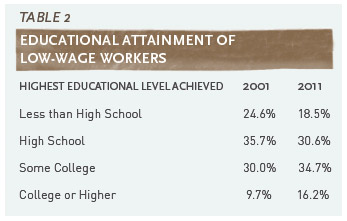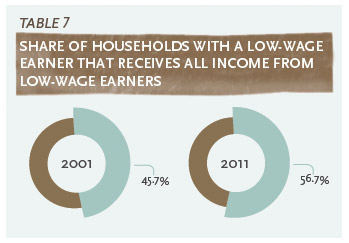Via Micah Uetricht, UIUC's Marc Doussard, an expert in low-wage labor markets, just published a report on that topic. I've written before about the low-wage recovery and the decline of the middle-class, and Doussard's report shows how that manifests itself in Chicagoland. Droussard set the low-wage threshold at $12/hr, well above the official poverty threshold, and above minimum wage as well, but at the border of "self-sufficiency":
For single adults living on the north side of Chicago, the typical self-sufficiency wage (inflation-adjusted to 2011 values) worked out to almost exactly $12 per hour, or roughly $24,000 per year. We use that figure as the cut-off for identifying the low-wage workforce in the Chicago area. Because many low-wage workers support families or live in larger households, this is a fundamentally conservative measure of the low-wage workforce. For four-person families with a single wage-earner, for example, the hourly self-sufficiency wage exceeds $14 per hour.
Above that, one's wage should be enough to cover basic needs in the Chicago area. Below that are low-wage workers, for the purposes of the study. And that population has grown—a lot—in Chicago:
31.2 percent of payroll employees ages 18-64 worked in low-wage jobs (paying $12 or less per hour) in 2011. This represents a substantial increase from the 23.8 percent of workers employed in low-wage jobs in 2001.
And 94 percent of low-wage earners are over 20; they're not kids. That falls to 57.4 percent over the age of 30, still a high number. The big demographic difference, which explains some of the dropoff between ages 20 and 30, is education:

Again, this is in keeping with national trends. The difference between finishing high school and attending but not finishing college, in terms of labor returns, is not terribly high. The return on finishing college is tremendous. But there's worrisome data there as well—the percentage of the low-wage workforce with a college degree increased a great deal over the past decade, at a much higher rate than the "some college" contingent. In turn, better-educated workers push less-educated workers off the bottom of the ladder as they slide down it.
The result is a lot of families depending on low wages to get by, instead of just to supplement a non-low-wage income:

As Doussard writes (emphasis mine):
In 2001, a majority of low-wage earners in the Chicago region lived in households with higher-wage earners. This “mixed” household composition helped to shield some low-wage workers from low overall household income….
The growth in households relying solely on low-wage workers is greater than the growth of any other demographic component of the low-wage workforce. This makes clear an unfortunate characteristic of the Chicago labor market: the typical low-wage job is now held by a breadwinner. These findings underscore that low-wage work is not a marginal problem confined to a few unfortunate pockets of the population, but rather a critical issue facing working families of all backgrounds.
In the whole report, that's the most chilling bottom line. It's worth keeping in mind if/when unemployment rates drop, as they did in August: how much do those jobs pay, and how much do they lift people out of poverty? In the Sun-Times, Francine Knowles has more.


